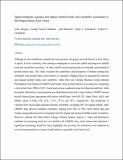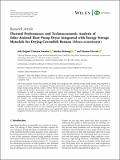Search
Now showing items 1-10 of 12
Potential use of zero-valent iron in enhancing performance and resource recovery during the anaerobic digestion of domestic sewage
(NM-AIST, 2024-08)
Incorporating metallic iron (Fe
0
) into anaerobic digesters can improve organics (chemical
oxygen demand (COD)), phosphorus, and nitrogen from contaminated water. However, no
study has systematically assessed ...
Assessment of Mpanda groundwater contamination and the effectiveness of the baobab seeds-derived biochar for iron removal from groundwater
(NM-AIST, 2024-08)
Groundwater in Mpanda District, Tanzania, faces excessive iron content, causing a reddish brown colouration due to oxidized iron species. The present study evaluated Mpanda
groundwater contamination and the effectiveness ...
Optimization of arsenic(III) and mercury(II) removal from non-competitive and competitive sorption systems onto activated carbon
(NM-AIST, 2024-07)
Heavy metals exist in the ecosystem both naturally and due to anthropogenic activities and as
recalcitrant pollutants; they are non-biodegradable and cause acute and chronic diseases to
human beings and many lifeforms. ...
Solvothermal liquefaction of orange peels and catalytic upgrading of biocrude into transportation fuel over a hybrid catalyst
(NM-AIST, 2024-08)
The efficient valorization of biomass for energy-derived biocrudes is essential for effective
waste management. However, the production of biocrudes with high energy and reduced
oxygen contents during the liquefaction ...
The removal of arsenic from synthetic solution using a sand filter coupled with zero valent iron
(NM-AIST, 2024-07)
Contamination of groundwater with arsenic (As) poses a serious risk to public health,
demanding the development of effective remediation technology. This study investigated the
use of sand filters coupled with of ...
Naturally occurring metal oxides from rocks as capacitive deionization electrode materials for antibacterial activities
(NM-AIST, 2024-01)
The availability of clean and safe drinking water remains a prominent challenge in most parts of
the world. Drinking water should be free from harmful microorganisms, salt as well as other
organic and inorganic ...
Spatial-temporal seasonal and annual rainfall trends and variability assessment in the Pangani Basin, East Africa
(Elsevier, 2024-12)
Although in situ rainfall data remains the most accurate, the gauge network density in East Africa is sparse. It lacks continuity, thus making it inadequate to assess the spatial and long-term rainfall trend and variability ...
Thermal Performance and Technoeconomic Analysis of Solar-Assisted Heat Pump Dryer Integrated with Energy Storage Materials for Drying Cavendish Banana (Musa acuminata)
(Hindawi, 2024-02-02)
This study examines a novel solar-assisted heat pump dryer integrated with a thermal energy storage system using soapstone as
storage material. The dryer is investigated through experimental analysis across three operating ...
Techno-economic evaluation of transesterification processes for biodiesel production from low quality non-edible feedstocks: Process design and simulation
(ELSEVIER, 2024-06-15)
The global demand for fossil fuels has led to increased pollutant emissions and depleted fossil fuel resources. Biodiesel, a fossil fuel alternative, is widely produced via transesterification. This study assesses the ...
Emerging pollution, antimicrobial resistance, and the applicability of biochar adsorbents: A comprehensive study in African water systems
(NM-AIST, 2024-07)
The impacts of antimicrobial resistance (AMR) extend far beyond clinical settings, permeating
into agriculture and the economy, precipitating dire consequences such as compromised
treatment efficacy, diminished ...










